
 |
|
|
Nursery & Forest
Volume 64 Number 19 Date 11/07/2019 NURSERY INSPECTION - The Nursery Program licensed 580 nursery growers and 1,139 retailers this year, with personnel performing 813 site inspections statewide. Annual inspections are prioritized for out-of-state shippers and those holding a Plant Health Certificate. The top 10 insects and diseases found this season were, by total number of detections: viruses, powdery mildew, apple scab, leaf spots, Japanese beetle, leafminers, aphids, winter injury, tar spot and rusts. Summarized below are highlights from the 2019 inspections. BOXWOOD BLIGHT - Nursery inspectors collected 107 boxwood and pachysandra samples for laboratory testing this year. Nine boxwood samples, including the varieties 'Green Velvet' and 'Korean,' were positive for boxwood blight. The infected plants came from two different big-box retailers in Dane and Portage counties and two nurseries in Kenosha County. Boxwood blight was also found on shrubs at a Dane County residence in late October, marking the first report of the disease in the Wisconsin landscape. RAMORUM BLIGHT - DATCP announced on August 23 the first interception of Phytophthora ramorum, or Ramorum blight in Wisconsin, on rhododendron imported from Washington State. The find resulted from a July trace-forward survey of 59 garden centers and nurseries that received potentially infected stock from the Washington supplier. Wisconsin inspectors collected 43 samples, but only one rhododendron in a Marathon County nursery was positive for the disease. In late October, another potential Ramorum blight introduction was reported on 'Double Red Knockout' rose plants at Walmart. The roses originated in an Oklahoma nursery where blight-infected plants were found, and all were sold before regulatory actions could be taken. DATCP and the UW are advising consumers who purchased azaleas, rhododendrons and roses in 2019 to monitor plants for leaf and shoot dieback symptoms next season. Suspect plants may be sent to the UW-Madison Plant Disease Diagnostic Clinic for free testing: href=https://pddc.wisc.edu/sample-collection-and-submission/. VIRUSES OF ORNAMENTALS - Plant viruses continued to be one of the most prevalent plant health issues in Wisconsin nurseries this year. Forty-eight percent or 113 of the 234 symptomatic ornamental samples submitted by inspectors to the Plant Industry Lab for testing in 2019 were positive for at least one virus. The most common were potyviruses (61 positives), followed by hosta virus X (16 positives), tobacco rattle virus (13 positives), and ilarviruses (7 positives). Delphinium plants sent to USDA for further analysis tested positive for potato virus S and a caulimovirus. DATCP enforces a zero tolerance policy for viruses and cautions nursery stock growers and retailers to avoid propagating or selling virus-infected plants. MAGNOLIA SCALE - Reports from inspectors and homeowners indicate this scale insect pest has become more prevalent in the landscape and on nursery stock in the last 5-6 years. Seven cases of magnolia scale at nursery locations in Kenosha, Washington and Waukesha counties were documented this season. VIBURNUM LEAF BEETLE - Nursery inspections found 18 cases of the viburnum leaf beetle (VLB) in southeastern Wisconsin in 2019. This newly-established pest feeds exclusively on the leaves of viburnums, and both the adults and larvae cause extreme defoliation and eventual shrub mortality after successive years of infestation. Native viburnums are an important understory component of many Wisconsin woodlands and are at risk as VLB?which now occurs in Iron, Kenosha, Milwaukee, Ozaukee, Walworth, Waukesha, Washington and Winnebago counties?continues to spread. -- Sam Fieweger, Shanon Hankin, Liz Meils, Anette Phibbs and Renee Pinski, DATCP EUROPEAN CHAFER - This destructive lawn grub was identified in Langlade County on July 10 by UW-Madison Entomologist PJ Liesch. The European chafer has been established since 2013 in Door County, where it has caused extensive lawn damage in Sturgeon Bay and surrounding areas. Its larvae are considered a more serious turf pest than the Japanese beetle because they feed later into the fall and earlier in spring, and even resume activity during warm periods in winter. -- Krista Hamilton, DATCP Entomologist ELONGATE HEMLOCK SCALE - Hemlocks from three nurseries in Ozaukee and Milwaukee counties were removed from sale in May and July due to elongate hemlock scale (EHS) infestation. The imported plants had been unsuccessfully treated with dinotefuran insecticide, as viable scales could still be found on the plants after treatment. This invasive pest is not known to be established in the state, and there is concern for the Christmas tree industry and native conifers given its broad host range, which includes fir, hemlock, pine and spruce. Last winter, DATCP inspectors intercepted EHS on holiday wreaths and other evergreen decorations at several large chain stores. EMERALD ASH BORER - Fifty-two Wisconsin counties are now infested with EAB. New detections in 2019 included Pierce County (River Falls) in July, one new tribal find on Oneida Nation land in August, and 52 more municipal confirmations. The coordinated state and federal EAB trapping program was discontinued after DATCP enacted a statewide quarantine last year. WALNUT TWIG BEETLE - A trapping survey to detect the walnut twig beetle was conducted at eight sites in Buffalo, Chippewa, Columbia, Dane, Grant, Iowa, Sauk and Trempealeau counties. Selected trapping locations included five sawmills, two walnut-dominant forestlands, and a walnut plantation. Twenty-six baited Lindgren funnel traps were monitored from mid-May through early September. No beetles were captured. DATCP has conducted surveys for walnut twig beetle since 2011 when an exterior quarantine for thousand cankers disease went into effect. LEAF BEETLE - Needle feeding damage by the native leaf beetle Cryptocephalus schreibersii was observed in August on balsam, Canaan, and Fraser fir trees in Chippewa and Eau Claire counties. The damage caused browning of current-year needles and was significant enough to make the Christmas trees unsaleable in certain fields. More commonly associated with pine, this beetle has not been widely collected in the state. Prior reports of C. schreibersii are from pine in Dane and Iowa County, as well as Fraser fir in Trempealeau County. SPOTTED LANTERNFLY - Surveys for this pest on tree-of-heaven at 31 urban sites in Dane, Grant, Milwaukee and Sauk counties, as well as on fruit trees and grape vines in 18 apple orchards and 12 vineyards, yielded negative results. Spotted lanternfly has not yet been found in the Wisconsin. -- Renee Pinski, DATCP Forest Entomologist GYPSY MOTH - An exceptional cold stretch January 29-31, with temperatures plummeting well below the -22°F lethal threshold for gypsy moth, caused high winter mortality in egg masses exposed above the snow line. Consequently, populations in 2019 were down considerably from previous years. Egg hatch began by May 13 in southern Wisconsin, about two weeks later than normal, and the first moths appeared on July 15 in Dane County. Pheromone traps deployed mainly across western Wisconsin captured a total of 52,396 male moths (in 10,964 traps) this season, a sharp decrease from 76,403 moths caught in 2018 and 108,008 in 2017. Currently, 50 of Wisconsin's 72 counties are under quarantine for gypsy moth. No new counties were added to the quarantine in 2019. -- Michael Falk, DATCP Gypsy Moth Trapping Coordinator 





|
|
|